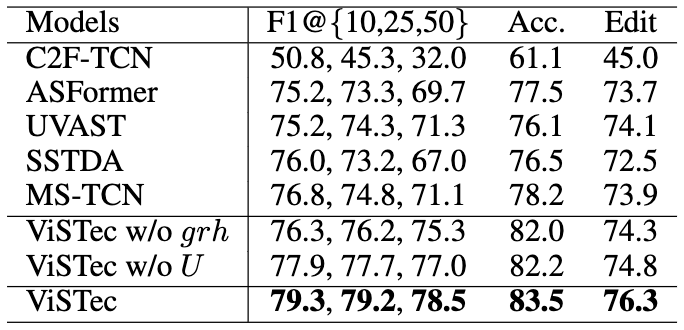Background: Racket Sports Analysis
Game Videos -> Technique Sequences -> Tactical Analysis
Racket sports, including tennis, badminton, and table tennis, are distinguished by their highly strategic nature, drawing millions of players and fans to explore tactical analysis. A game in racket sports consists of rallies, which are sequences of strokes executed by players alternately from both sides. Here, a stroke refers to the action of hitting the ball with a racket, and each stroke can employ a certain technique, such as "topspin" and "push." A tactic is characterized by a series of consecutive stroke techniques.
Background illustration
Experiments
Qualitative Demos
Ground Truth
ViSTec
Baseline

Our Result
Quantitative Results
SOTA Accuracy
Our proposed approach excels across all common evaluation metricsin video action segmentation, achieving state-of-the-art results in sports technique segmentation from broadcast game videos.

Real-time Performance
ViSTec demonstrates an inference speed of approximately 39.3 frames per second (fps) in offline tests on a single A100 GPU, thereby enabling the potential for real-time processing of broadcast game videos.
Case Studies
We present two case studies conducted with senior analysts from the Chinese table tennis team, which address the most critical and complex facets of sports analysis that require domain knowledge: technique analysis and tactical analysis.
Technical Level Analysis

Tactical Level Analysis

Case 1: Analyzing Personalized Characteristics of Technical Actions
As shown in the left figure, for Japanese players, technique "Block" and "Topspin" exhibits striking analogy, as do "Push" and "Short". These similarities within deep visual features "reveal the high consistency and deceptive nature of their certain techniques," noted by the experts. This observation furnishes valuable insights, allowing opponents to enhance their preparation and anticipation of the players' moves in specific techniques, a critical factor in the fast-paced world of racket sports. Similar analysis can be transferred to other players in real time, enabling the understanding of the unique characteristics of their opponent's actions.
Case 2: Discovering Optimal Tactical Choices
As demonstrated in the right figure (B), the sequence "Serve Short Topspin"exhibits the highest scoring rate. This suggests that when serving on our side and the subsequent opponent's stroke involves a "Short" technique, the optimal choice in terms of scoring rate is to respond with a "Topspin" stroke in the next play. Moving on to the right figure (C), it becomes evident that following two strokes of the "Serve" and "Short" techniques, persisting with another "Short" stroke or responding with "Others" leads to a sudden drop in scoring rate to around 0.43. This underscores that taking the initiative early in the game and launching an offensive increases our likelihood of winning.